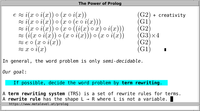Prolog implementation of the
Knuth-Bendix completion procedure
Prolog code: trs.pl
| Video: |

|
As an application of term rewriting, consider for example the
completion of the group axioms:
?- Es = [X*(Y*Z)=(X*Y)*Z, e*X=X, i(X)*X=e],
functors_order([*,e,i], Order),
completion(Es, Order, [], [], Rs),
maplist(portray_clause, Rs).
Or shorter, using the interface predicate equations_trs/2
to relate a list of identities to a convergent term
rewriting system (TRS):
?- equations_trs([X*(Y*Z)=(X*Y)*Z, e*X=X, i(X)*X=e], Rs),
maplist(portray_clause, Rs).
This yields the following convergent TRS:
i(A*B)==>i(B)*i(A).
A*i(A)==>e.
i(i(A))==>A.
A*e==>A.
A*B*C==>A*(B*C).
i(A)*A==>e.
e*A==>A.
i(A)*(A*B)==>B.
i(e)==>e.
A*(i(A)*B)==>B.
We can use this TRS to reduce—for example—the
term X*i(X) to its normal form:
?- equations_trs([X*(Y*Z)=(X*Y)*Z, e*X=X, i(X)*X=e], Rs),
normal_form(Rs, X*i(X), NF).
Gs = ...,
Rs = ...,
NF = e .
This shows that the left-inverse is also a right-inverse
in groups!
To decide equality between any two terms
in groups, simply reduce both of them to their respective
normal forms, and see whether they are identical. This only takes
a finite number of steps, since the TRS is convergent
and hence terminating.
Read The Power of Prolog
to understand the Prolog language features that are used in
the code. In particular, I recommend the following chapters:
Please write
to triska@metalevel.at if
you have any questions about this code or any other
aspects.
Main page

